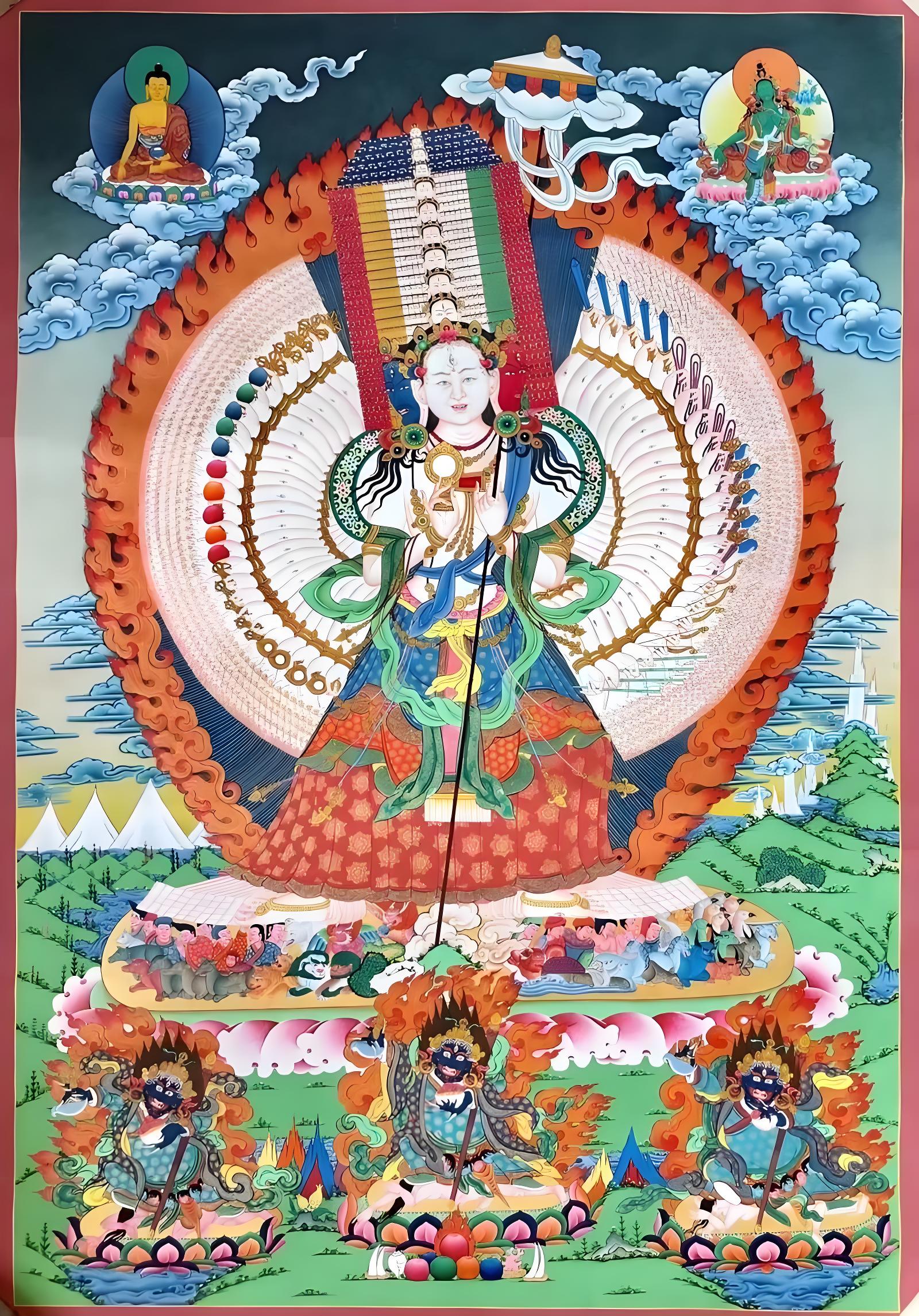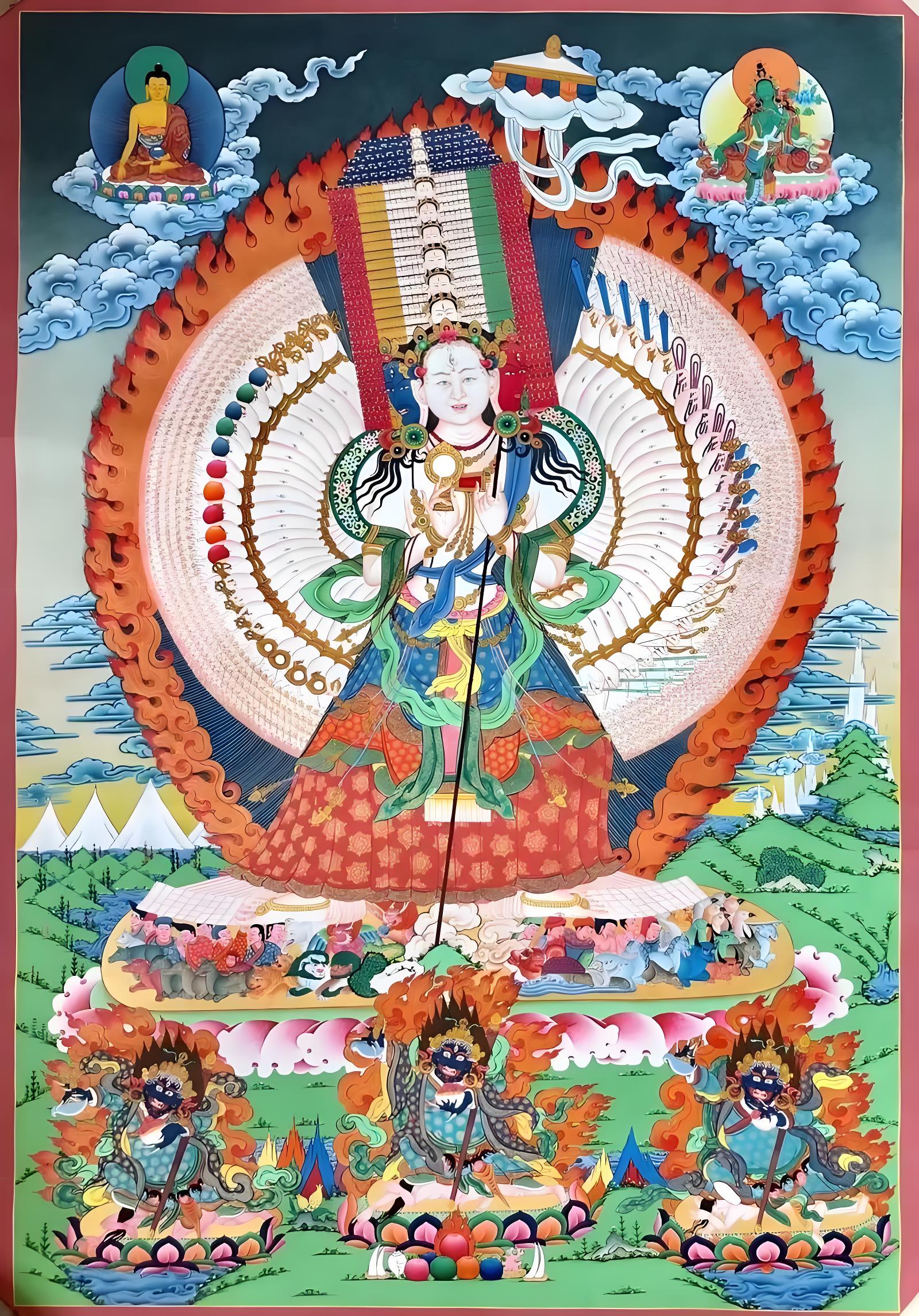type
status
date
slug
summary
tags
category
icon
password
AI summary
Tibetan Buddhism features a rich pantheon of deities. These figures play vital roles in spiritual practice. They are often depicted with complex symbolism. The deities can be categorized into different types.These include peaceful and wrathful forms. Understanding these deities can provide insight into Tibetan Buddhist philosophy. Let's explore some key figures.
Understanding the Kalacakra Deity

The Kalacakra deity, or "Wheel of Time," holds a high rank in esoteric Buddhism. It belongs to the Anuttarayoga Tantra class. This deity is a yidam, which means a personal deity. Kalacakra embodies time and cycles on cosmic and individual levels. Furthermore, it elucidates the process of spiritual evolution. The deity's complex form symbolizes various aspects of Buddhist philosophy and cosmology.
Appearance and Symbolism of Kalacakra
Kalacakra typically has a blue body. Its wisdom consort, or vidyā, is yellow. She is called the Great Seal of Emptiness. The deity has four faces and twelve arms. The blue body radiates five-colored light. This symbolizes the body of the Buddha. The four faces have different colors: blue, yellow, white, and red. These colors represent subduing, increasing, pacifying, and magnetizing activities respectively. They also symbolize the perfection of merit. Each face has three eyes. This represents the ability to see everything. A human skull crowns each head. A crescent moon and a double vajra adorn the top of the head. The 12 arms have 24 hands in total. The hands have varying colors. There are four pairs of blue, red, and white arms. Each finger from thumb to pinky is also colored yellow, white, red, blue, and green. Each finger is colored blue, red, and white from tip to palm.
Significance of Colors and Objects
The colors in the image of Kalacakra are highly symbolic. They fully reflect the meaning and function of colors in Tibetan esoteric Buddhism. Two of the 24 hands embrace the consort. They hold a bell and a vajra. This symbolizes the union of method and wisdom. The other hands hold various objects. These objects all have religious meaning. They express the deity’s wisdom and fearless power. The deity stands with the right leg extended. It steps on a red god of desire. The left leg is bent, stepping on a white demon. The complex iconography is a central part of the deity's practice.
Exploring the Forms of Pehar

Pehar is another significant figure in Tibetan Buddhism. He appears in various forms.[3][5][7][9][11][12] These forms fulfill his duty of protecting the Dharma. He overcomes obstacles in the snowy regions. Tibetans call them the "Five Guardian Kings." Each king has their own name, duty, and artistic representation. Furthermore, they have their own retinue and consorts. These images are often seen in Tibetan Buddhist temple statues.
Pehar, King of Body
The first emanation is Pehar, King of Body. He is also known as the Guardian King of Body. His original name was Menpubucha. He presides over the conch shell palace in the East. His body is black, with one face and two arms. His right hand holds a vajra, and his left hand holds a long staff. He wears a black silk robe and hat. He rides a white female lion, led by a black bear. His consort is the Corpse Demoness. This form of Pehar embodies protection.[9][13]
Pehar, King of Merit
Pehar, King of Merit, is also known as the Guardian King of Merit. He was originally named Bird-Shaped Being. He resides over the golden palace in the South. His body is also black, with one face and two arms. His right hand holds a battle ax, and his left hand holds a lasso. He wears a cloak made of snake and tiger skins. He also has a hat made of wicker and lambskin. A black horse with white hooves is his ride. Dragons, monkeys, and apes accompany him. His consort is a black, four-faced goddess named Sekjibhuzima.
Pehar, King of Speech
Next is Pehar, King of Speech, or the Guardian King of Speech. He was originally known as War God One Man. He presides over the red coral palace in the West. He has one face and two arms. His right hand holds a cane, and his left hand waves a sandalwood stick. Black silk clothes and a wicker hat adorn him. He rides a white-hooved mule, led by Menpubucha. His consort is the goddess Holding a Beautiful Lotus. This form focuses on the power of sacred words.
Pehar, King of Mind
Pehar, King of Mind, is also called the Guardian King of Mind. He was originally named Emperor Shakra. He is at the center and is the main deity. However, sometimes Pehar himself can be in the center. His body is blue-black, with one face and two arms. He has a fierce expression with bared teeth. His right hand holds a lasso, and the left hand holds a sharp blade. He wears a bearskin coat and a black silk cloak, with a black silk headdress. His ride is a white elephant with a long trunk. Menpubucha leads the elephant, and the yaksha, Yanglaibai, leads the way on horseback. His consort is called the Goddess Sounding Like a Scattered Lotus.
Pehar, King of Karma
Finally, there is Pehar, King of Karma, or the King of Activity. He is the original form of Pehar, and also called Xiesongduojimiwoqie. He has three heads of different colors: white, sky blue, and red. Each of his six hands holds a different ritual implement. The three right hands hold an iron hook, an arrow, and a sword. Conversely, the three left hands hold a knife, a bow, and a staff. He wears a white silk top, with human and tiger skins around him. He also wears a wicker hat and rides a white lion, led by Menpubucha. His main companion deity is Achuma. The consort is called the Demon Shining Minggamu. This form embodies dynamic action.
The Great White Umbrella Goddess

The Great White Umbrella Goddess, or "Dukarm" in Tibetan, is a very powerful figure. She is the embodiment of all the Buddhas’ activities. Her manifestations are diverse. They include forms with a thousand arms, ten arms, six arms, and two arms. She is a Buddha of the esoteric tradition. Furthermore, she is a manifestation of both exoteric and esoteric Buddhism. The Great White Umbrella Goddess is considered the mother of the Buddhas of the three times. She is also a vajra deity. Her scripture is considered the essence of all mantras. This deity helps to reverse unfavorable circumstances. She also subdues demons.
Peaceful and Wrathful Aspects
The Great White Umbrella Goddess has peaceful and wrathful aspects. The peaceful aspect is represented with one face, two arms, and three eyes. She sits in the vajra posture. Her right hand is in the gesture of fearlessness. The left hand holds a white umbrella at the chest. Her body is pure white and adorned with various ornaments. The wrathful aspect is much more complex. She also appears white with three faces. Each face has three eyes. Countless heads stacked like an umbrella are above the three heads. Innumerable arms surround the body, forming a large circle. Each hand has an eye. Also, each hand holds a ritual implement. Two primary arms are in front of the chest. The left hand holds a vajra, and the right hand holds a white umbrella. She steps on countless beings from the six realms, symbolizing her protection for all. This does not represent subjugation but rather represents her protection for all beings.
Significance of the Goddess
The Great White Umbrella Goddess is an invincible protector. She protects against supernatural dangers. She can help heal illnesses. She also helps dispel spiritual harm. Moreover, she offers protection against natural disasters and bad intentions. Her practice is considered a complete practice. This is due to her emphasis on meditation and the Eightfold Path. The parasol is a symbol of high rank and divinity. It represents the spiritual sovereignty of the Buddha.
In conclusion, the deities of Tibetan Buddhism are a fascinating study. Figures like Kalacakra, Pehar, and the Great White Umbrella Goddess embody profound spiritual concepts. These deities are not merely symbolic, but active participants in the spiritual lives of practitioners. They serve as both sources of guidance and protection.
上一篇
Deities in Tibetan Buddhism (7): The Five Dzambhala|Jambhala
下一篇
The Profound Significance of Mantras in Tibetan Buddhism
Loading...






